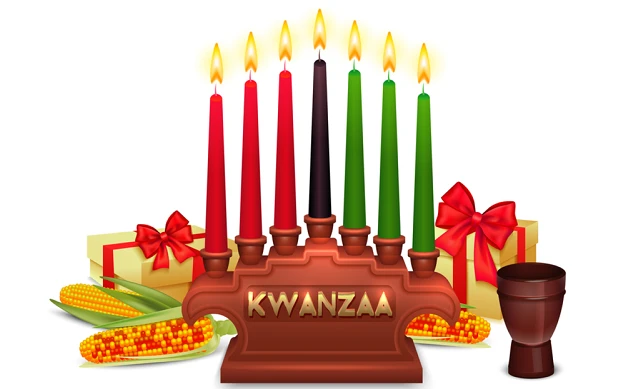Lifestyle
Kwanzaa 2019: History, Significance, Principles, and Symbols of Kwanzaa

Kwanzaa falls between December 26th and January 1st every year, culminating in gift-giving and a feast. Kwanzaa is a week-long holiday regarding African culture and customs. Kwanzaa is seven days in length celebration that is celebrated in the United States, as well as different nations with populaces of the African diaspora in the Americas to honor African heritage in African-American culture.
It is a holiday that celebrates and praises African culture in the African-American community as well as in the World African community. This holiday is celebrated from December 26th through January 1st.
The name Kwanzaa originates from the phrase ‘matunda ya kwanza’ which signifies ‘first fruits’ in the Swahili language (an Eastern African language spoken in nations including Kenya, Uganda, Tanzania, Mozambique, and Zimbabwe). Kwanzaa is, for the most part, celebrated in the USA.
Maulana Karenga, an African-American leader, proposed this recognition and it was first celebrated between December 1966 and January 1967.
Even though Kwanzaa (first day) is not a public holiday, businesses and schools might be shut because it falls on a similar date as Day After Christmas Day in 2019, which is a public holiday in 4 states.
Kwanzaa History
Kwanzaa is a holiday tradition that depends on the “first harvest” festivities in Africa. In recorded history, these first harvest celebrations can be followed right back to Nubia and Egypt and can be found in cultures all over Africa. While a large number of these first-fruit festivities may vary starting with one society to another, they all shared a few principles in common. These principles incorporate individuals assembling to celebrate, recognizing the maker and thanking him for his blessings. a remembrance of the previous, a re-commitment to African cultural ideas and an opportunity to praise community.
Established in these principles, particularly those of the Ashanti and the Zulu, Kwanzaa emerged from the Black Freedom Movement in 1966 in the United States. It was made by Dr. Maulana Karenga – a professor of Black Studies at California State University, Long Beach, USA. He made it after the Watts riots as an approach to unite African-Americans as a community. He gave it the name Kwanzaa – a word that is taken from the phrase “matunda ya kwanza” and is Swahili for “first-fruits.”
Kwanzaa was initially imagined by Dr. Maulana Karenga as an oppositional option in contrast to Christmas. Be that as it may, in later years he changed his situation as to not alienate African-American Christians and later stated that Kwanzaa was not made to give individuals an option in contrast to their very own religious holidays.
From 1966 through the finish of the 20th century, the thought and practice of Kwanzaa started to gradually increment in popularity over the United States. At that point, its popularity started to increment drastically after the beginning of the 21st century as the thought and practices of this holiday started to spread through ordinary media as well as through the Internet. In 2004, a study indicated that somewhat less than 5 million African-Americans planned to praise the holiday that year. Nonetheless, after two years, another study indicated that very nearly 28 million African-Americans had moved toward commending the holiday in 2006. In 2009, the popularity of Kwanzaa was additionally supported by the release of the narrative movie about Kwanzaa called the “Black Candle,” a movie described by Maya Angelou and coordinated by M. K. Asante. From that point forward, Kwanzaa has spread the whole way across North American as well as parts of Europe and Africa too.
Made by Dr. Maulana Karenga in 1966, Kwanzaa is commended every year by more than 30 million individuals around the world, more than seven days from December 26 to January 1. The values of Kwanzaa, Nguzo Saba (The Seven Principles), are critical tools for tending to the issues confronting the African-American community. Ceremonies will be led by Brotha’ Clint Sockwell and Malik Seneferu. There will be a candle lighting and pouring of libation ceremony, live entertainment and a feast at every occasion.
The name Kwanzaa is gotten from the phrase “matunda ya kwanza” which signifies “first fruits” in Swahili. Every family observes Kwanzaa in its particular manner, yet festivities frequently incorporate songs and dances, African drums, storytelling, poetry reading, and an enormous customary feast. On every one of the seven nights, the family accumulates and a child lights one of the candles on the Kinara (candleholder), at that point one of the seven principles is talked about. The principles, called the Nguzo Saba (seven principles in Swahili) are values of African culture which add to building and strengthening community among African-Americans. Kwanzaa likewise has seven fundamental symbols that represent values and concepts reflective of African culture. An African feast, called a Karamu, is held on December 31.
How to celebrate Kwanzaa?
A Kwanzaa function regularly additionally incorporates the performance of music and drumming, a reflection on the Pan-African colors of red, green and black and a discussion of some parts of African history. Ladies frequently wear brightly colored traditional clothing. Some cultural associations hold special exhibitions of African impacted art or performances during the time of the festivals.
Initially, the individuals observing Kwanzaa didn’t mix any elements of different celebrations into their festivals. Be that as it may, in recent years, it has gotten increasingly common for individuals to mix elements of Kwanzaa in with Christmas or New Year festivities. For example, a family may have both a Christmas tree and a Kwanzaa candle ion display in their home. This empowers them to remember both Christian and African inspired traditions for their lives during this season.
Kwanzaa is a holiday honoring the culture and traditions of individuals of African origin. It is praised by individuals from a scope of African nations and their descendants. Kwanzaa comprises of seven days of festivities, which closes with a feast and the exchange of gifts. During the festivals, candles are lit and drinks are poured. A drink is a name given to a custom pouring of a beverage as an offering to a god. During Kwanzaa, a wooden unity cup is utilized to pour the drinks.
During Kwanzaa, a special candleholder called a kinara is utilized. A kinara hold seven candles, three red ones on the left, three green ones on the right with a black candle in the middle. Every night during Kwanzaa a candle is lit. The black, center, the candle is lit first and afterward, it alternates between the red and green candles stating with the ones outwardly and moving inwards. This is very like the lighting of the menorah in the Jewish Festival of Lights, Hanukkah.
During Kwanzaa, individuals decorate their homes with straw mats, ears of corn, and a candle holder called a kinara. They light a candle in the home each night and may exchange homemade gifts. The seven-day festivity closes with a feast, generally held at a community center and including music and dancing. This spiritual holiday focuses on seven fundamental principles: solidarity (Umoja), self-determination (kujichagulia), collective work and responsibility (ujima), cooperative economics (ujamaa), purpose (nia), creativity (kuumba), and faith (Imani).
The Seven Principles (Nguzo Saba) of Kwanzaa
Every one of the seven days of Kwanzaa praises an alternate principle. These principles are accepted to have been vital to building strong, beneficial families and communities in Africa. During Kwanzaa, celebrants greet each other with “Habari Gani,” or “What’s the news?” The principles of Kwanzaa form the appropriate responses.
The Principles of Kwanzaa
- Umoja (oo-MOH-JA)
Which means: unity
Activity: To strive for and keep up unity in the family, community, country, and race.
2. kujichagulia (Koo-jee-cha-goo-LEE-yah)
Which means: self-determination
Activity: To characterize and name ourselves, as well as to make and speak for ourselves.
3. ujima (oo-JEE-mah)
Which means: collective work and responsibility
Activity: To assemble and keep up our community together and make our siblings’ issues our issues and to solve them together.
4. ujamaa (oo-JAH-ma)
Which means: cooperative economics
Activity: To manufacture and keep up our very own stores, shops, and different businesses and to benefit from them together.
5. nia (nee-AH)
Which means: a feeling of purpose
Activity: To make our aggregate work the structure and creating of our community to reestablish our people to their traditional greatness.
6. kuumba (Koo-OOM-bah)
Which means: creativity
Activity: To do consistently as much as we can, in the manner in which we can, to leave our community more beautiful and beneficial than we acquired it.
7. Imani (ee-MAH-nee)
Which means: faith
Activity: To accept every one of our hearts in our people, our parents, our teachers, our leaders, and the righteousness and triumph of our battle.
The Seven Symbols of Kwanzaa
Celebrants beautify with red, black, and green as well as African-style textiles and leaders. At the core of Kwanzaa symbolism, be that as it may, are the seven symbols.
The Seven Symbols of Kwanzaa
- kikombe cha Umoja
Which means: the unity cup
Activity: Celebrants drink from this cup to pay tribute to their African predecessors. Before drinking, every individual says “Harambee,” or “let’s pull together.”
2. kinara
Which means: the candleholder, which holds seven candles
Activity: It said to symbolize stalks of corn that branch off to form new stalks, much as the human family is made.
3. mazao
Which means: fruits, nuts, and vegetables
Activity: These help celebrants to remember the harvest fruits that supported the individuals of Africa.
4. mishumaa saba
Which means: the seven candles that represent the seven principles
Activity: An alternate candle is lit every day. Three candles on the left are green; three on the right are red, and in the middle is a black candle.
5. mkeka
Which means: mat
Activity: The symbols of Kwanzaa are organized on the mkeka, which might be made of straw or African cloth. It symbolizes the establishment whereupon communities are manufactured.
6. vibunzi (plural, muhindi)
Which means: ear of corn
Activity: Traditionally, one ear of corn is put on the mkeka for every kid present.
7. Zawadi
Which means: gifts
Activity: Traditionally, educational and cultural gifts are given to kids on January 1, the last day of Kwanzaa.
Kwanzaa festivities differ from family to family. A few families stay with carefully Kwanzaa related practices, while different families mix elements of Kwanzaa into their Christmas festivities. Be that as it may, most Kwanzaa festivities depend on Nguzo Saba – or the seven principles of Kwanzaa.
-

 Sports4 weeks ago
Sports4 weeks agoFIFA Club World Cup 2025: Complete List of Qualified Teams and Groups
-

 Sports2 weeks ago
Sports2 weeks agoAl Ahly vs Inter Miami, 2025 FIFA Club World Cup – Preview, Prediction, Predicted Lineups and How to Watch
-
Health1 week ago
Back to Roots: Ayurveda Offers Natural Cure for Common Hair Woes
-
World4 weeks ago
Omar Benjelloun: Strategic Architect Behind Major Financial Deals in the MENA Region
-

 Sports3 weeks ago
Sports3 weeks agoFIVB Men’s Volleyball Nations League 2025: Full Schedule, Fixtures, Format, Teams, Pools and How to Watch
-

 Tech1 week ago
Tech1 week agoFrom Soil to Silicon: The Rise of Agriculture AI and Drone Innovations in 2025
-

 Startup2 weeks ago
Startup2 weeks agoHow Instagram Is Driving Global Social Media Marketing Trends
-

 Science4 weeks ago
Science4 weeks agoEverything You Need to Know about Skywatching in June 2025: Full Moon, New Moon, Arietid Meteors, and Planetary Marvels













